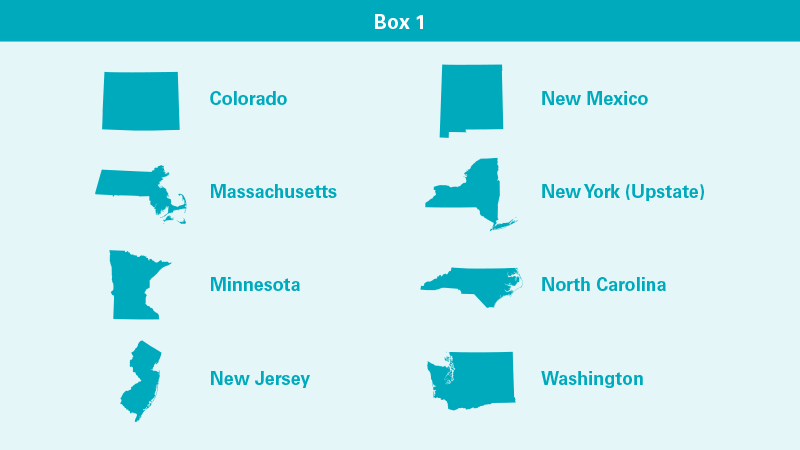Understanding CMMI’s Making Care Primary Model
In June 2023, the Centers for Medicare & Medicaid Services’ (CMS) Center for Medicare & Medicaid Innovation (CMMI) announced its newest, voluntary, multi-payer Alternative Payment Model (APM) called Making Care Primary (MCP). Eight states (see Box 1) were selected to participate in the model, and responses to the Request for Application for interested providers are due by December 14, 2023.
MCP has three primary goals:
- Ensure beneficiaries in participating organizations (e.g., health systems, group practices, solo primary care practices, Federally Qualified Health Centers (FQHCs), Indian Health Programs) receive primary care that is integrated, coordinated, person-centered, and accountable.
- Create a pathway for primary care clinicians—especially small and independent practices, rural providers, and organizations supporting underserved communities—to adopt prospective, population-based payment to become more accountable for cost and quality of care for their population of patients.
- Improve the quality of care and health outcomes while reducing or maintaining program expenditures.
MODEL OVERVIEW AND CONSIDERATIONS
Launching July 1, 2024, MCP builds on CMMI’s primary care portfolio to offer providers a considerably longer model performance period—10.5 years—and an opportunity for providers who lack value-based care experience in Medicare to join MCP and assume increased care delivery responsibilities over time, supported by innovative payment models.
The model increases a provider’s primary care accountability over time through a tiered structure while moving participants away from a fee-for-service (FFS) model as they progress through MCP’s three tracks. Track 1 is designed for providers who do not have previous APM experience in Medicare (e.g., other CMMI models, two-sided risk under the Medicare Shared Savings Program). Track 1 participants are able to utilize tools and resources to build the provider’s capacity, such as investing in staffing, developing care coordination protocols, and managing aggregated data. Tracks 2 and 3 increase participants’ care delivery expectations as they begin to be reimbursed under the model’s prospective population-based payment for primary care services.
Model Eligibility. Eligible providers include:
- Medicare-enrolled organizations that provide primary care services to Medicare beneficiaries, including solo primary care practices, group practices, health systems, FQHCs, and eligible Indian Health Programs.
- Critical Access Hospitals that have selected Standard or Method I billing.
- Former Comprehensive Primary Care (CPC) or Comprehensive Primary Care Plus (CPC+) practices, as well as Primary Care First (PCF) practices that submitted a withdrawal request before May 31, 2023, or were terminated from PCF prior to May 31, 2023.
Care Delivery Requirements. Care delivery requirements fall into three key domains:
- Care Management—Following other primary care-focused models, MCP focuses on chronic condition management and self-management.
- Care Integration—MCP aims for participants to better integrate behavioral health and specialty care into patients’ care. Practices will systematically screen for key behavioral health conditions and work to establish collaborative care arrangements with specialists.
- Community Connection—MCP furthers CMMI’s efforts to center health equity in APMs. Model participants will be required to implement health-related social needs screenings and utilize community health workers to aid in service navigation.
Payment Model. Reimbursements for MCP align with the three tracks:
- Track 1: FFS reimbursement; however, more experienced providers can immediately accept the Medicare Prospective Primary Care Payment (PPCP).
- Track 2: Hybrid reimbursement (50% PPCP and 50% FFS).
- Track 3: 100% PPCP.
MCP offers other supportive payment structures such as a new e-consultation code and two upside-only payments:
- Performance Incentive Payment (PIP): A payment linked to provider performance on key quality measures (the incentive opportunity increases over time for the PIP).
- Enhanced Services Payment (ESP): A population-based payment meant to reflect the provider’s attributed population that is adjusted based on both clinical and social risk (the ESP decreases over time in recognition that the PIP increases substantially).
Model Considerations. There are different factors that potential MCP providers and payers, as well as selected state Medicaid agencies, may consider when developing successful MCP models, including:
|
Potential Providers |
Potential Payers |
Selected States |
|
Providers are able to start MCP at any track—with certain criteria for Track 1 eligibility—and can use the model’s relatively long lifespan to make investments in multi-payer primary care delivery as they are required to move into subsequent tracks. CMMI requires that participants move into the next track every 2.5 years until they hit Track 3. Successful providers will have the capacity to ingest clinical and payer data to improve clinical workflows and inform patients’ care management. Track 1 participants can receive upfront funding to make investments in data systems, staffing needs, and other activities related to MCP’s goals. |
CMMI does not expect payers to mirror Medicare exactly, but it envisions multi-payer alignment in MCP as payers work to create the same incentives for accountable primary care through directional alignment on key areas, including quality measurement, type and form of payer data, learning priorities, and movement away from FFS. |
The eight selected states should consider their holistic population health and primary care goals in assessing how MCP may help progress and align these initiatives. Considerations for state Medicaid agencies may include, but are not limited to, how MCP:
Beyond Medicaid, states can also use MCP participation to explore a state’s value-based care goals in other state-run insurance (e.g., state employee health plans, state-based marketplaces) and any potential for alignment with state executive or legislative authority to set state-level primary care cost and spending targets. |
NEXT STEPS AND MORE INFORMATION
- CMS is accepting provider applications via their web portal through Thursday, December 14, 2023, at 11:59 p.m. ET. Other CMMI resources on MCP are available here.
- For more information on MCP, view Manatt Health and CMS’ recent free webinar, Investing in a Strong Primary Care Health System: An Overview of CMMI’s Making Care Primary Model.
Contact Alison Shippy at ashippy@manatt.com for help with any aspect of this important new model.

